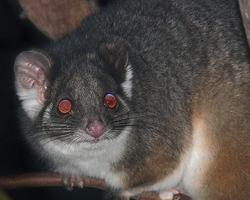
Váhy a míry
| Délka | od 35 do 50 cm |
|---|---|
| Hmotnost | 1 kg |
| Délka ocasu | od 45 do 60 cm |
Popis zvířete
The Southern Greater Glider (Petauroides volans) is an intriguing and unique marsupial native to the forests of eastern Australia. This nocturnal creature is part of the Pseudocheiridae family, which includes other gliding possums, but it distinguishes itself with its larger size and distinctive lifestyle. The Southern Greater Glider is a testament to the remarkable adaptability and diversity of Australia's native wildlife.Physically, the Southern Greater Glider is quite striking. It has a robust and fluffy body, typically measuring between 35 to 45 centimeters in length, with an additional tail length almost equal to its body, helping it to balance and steer while gliding. The fur is usually a soft grey or brown, with lighter shades on the underbelly, and it possesses a large, round head with big, forward-facing eyes that enhance its night vision. One of its most distinctive features is the large, fluffy ears that resemble those of a koala, to which it is not closely related.
What sets the Southern Greater Glider apart from other arboreal marsupials is its remarkable ability to glide. This ability is facilitated by a membrane called the patagium, which stretches from the elbow to the ankle on each side of its body. When the glider leaps into the air and extends its limbs, the patagium catches the air, allowing it to glide effortlessly from tree to tree. This adaptation is not just a means of locomotion but a sophisticated evolutionary strategy to escape predators and exploit scattered resources without descending to the ground. The glider can cover distances of up to 100 meters in a single glide, although distances of 20 to 50 meters are more common.
The Southern Greater Glider is a solitary and territorial animal, with individuals maintaining large home ranges that they mark with scent. These marsupials are also highly specialized feeders, with their diet consisting almost exclusively of eucalyptus leaves. They have a slow metabolism, which is an adaptation to their nutrient-poor diet, and they spend most of their time resting in tree hollows during the day to conserve energy.
Reproduction in the Southern Greater Glider is not well understood, but it is known that they give birth to a single joey per year, which then remains in the mother's pouch for several months. During this time, the joey is completely dependent on the mother for nutrition and protection.
Unfortunately, the Southern Greater Glider is facing significant threats from habitat destruction, primarily due to logging and land clearing for agriculture. Climate change also poses a long-term threat by affecting the availability of suitable habitat and food sources. As a result, their populations have declined, leading to their classification as vulnerable to extinction.
Conservation efforts for the Southern Greater Glider focus on protecting their habitat, particularly the preservation of old-growth forests that provide the hollows they need for shelter. Research into their ecology and behavior is also critical to inform effective conservation strategies and ensure that this unique and enchanting Australian marsupial can glide through the treetops for generations to come.
Mapa výskytu

Podobná zvířata
Nové fotografie zvířat
Top 10 zvířat
- Dolphin gull (Leucophaeus scoresbii)
- Japanese macaque (Macaca fuscata)
- Stone loach (Barbatula barbatula)
- Greek tortoise (Testudo graeca)
- Russian tortoise (Testudo horsfieldii)
- Diana monkey (Cercopithecus diana)
- Galápagos tortoise (Geochelone nigra complex)
- Moustached guenon (Cercopithecus cephus)
- Common flying dragon (Draco volans)
- Galápagos penguin (Spheniscus mendiculus)

